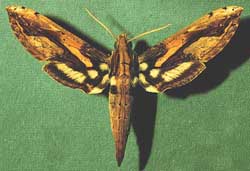
Xylophanes ceratomioides
Fw o.m. slightly scalloped.
Abdomen: three narrow, longitudinal lines; outer lines posteriorly divergent and expanded into triangular spots.
Costa: conspicuous subapical, apical black spots, largest subapical spot
triangular with inner point directed basally.
Median area running out to apex: pale brown with scattered black scales on veins; discal spot small,
black.
First four pm lines dissipate preapically before reaching costa, weak fifth line
runs to apex. First line slightly sinuate.
Second-fourth lines very scalloped near inner margin.
Oblique postmedian band dark with sinuate black lines within it, inner edge slightly undulate,
outer edge deeply excavate from CuA2 to just above M3,
forming a pale brown, oval patch; marginal area with black vein spots.
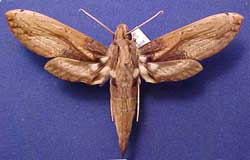
Xylophanes media
Similar to ceratomioides.
Fw o.m. less rounded below M2 than in ceratomioides; very slightly undulate.
Abdomen: three narrow lines; outer lines posteriorly divergent, not expanded into small triangular spots.
Fw elements more diffuse than in ceratomioides.
Costa lacking subapical, apical black spots.
Most distal antemedian line, most basal postmedian line meet on i. m. as in guianensis.
Pm band not clearly developed.
Hw subbasal, median bands: pale grey, shaded with brown, median band edges especially diffuse.
|
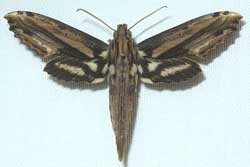
Xylophanes guianensis
Fw o. m. quite scalloped.
Outer abdominal lines not posteriorly divergent.
Fw costa: several conspicuous subapical and apical black spots, more proximate than ceratomioides,
the largest subapical spot quadrate.
Pm lines clearly visible within the postmedian area, almost straight, except toward inner edge of wing
(not scalloped as in ceratomioides)
Most distal antemedian line and most basal postmedian line meet on inner edge of forewing upperside;
pale brown excavated area on outer margin of postmedian band narrow
(more so than in Xylophanes xylobotes), rectangular and not well defined due to the visible presence within it
of the third, fourth and fifth postmedian lines.
Pale bands of hindwing upperside intermediate in coloration between those of Xylophanes ceratomioides and Xylophanes xylobotes.
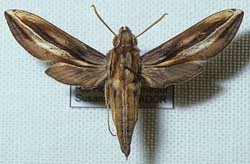
Xylophanes th. thyelia
Very small species.
Head: dark longitudinal line, bordered ventrally with buff, above antenna.
Tegula: dark brown median line, bordered on each side by
pale grey stripe, irrorated with pale purple.
Abdomen: brown midline, bordered by narrow grey lines; brown lateral line present on segments 2-4, bordered ventrally by pale buff line that
continues posteriorly to segment 7.
Short dark line present basal to first postmedian line, reaching as far as discal spot.
First, second, third pmls arise almost from wing base, quite oblique. First pml reaches to just beyond M1;
second ppml reaches Rs4; third & fourth pmls very narrow, close, sometimes fused for part of their length distally,
running from Rs4 to M3, below which they become diffuse series of minute spots (continuous and distinct below M3 in Xylophanes thyelia salvini).
Pal area between second, third pmls. Fifth pml runs from apex to M3 as
gradually broadening triangular patch. Apical area bounded by costa, fifth postmedian line and Rs4, and tornal area bounded by M3,
second postmedian line and CuA2, both pale brown and buff, with scattered individual black scales; Rs4, basal to second postmedian line, highlighted with
buff over distal half.
Hw: almost uniform grey-brown. Median band barely visible.
|
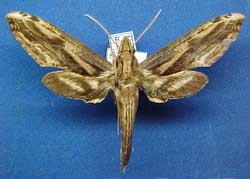
X. colinae
Abdominal lines like ceratomioides, but outer lines more continuous from segment to segment.
Smaller than ceratomioides and guiananesis, with more rounded wings, even more strongly scalloped
outer forewing margin than guianensis.
Most distal antemedian line and most basal postmedian line meet along i. m.
Pale brown excavated area on outer margin of postmedian band as in ceratomioides but narrower, appearing smaller.
Hw: subbasal, median bands orange-brown; off-white in ceratomioides and guianensis.
|
Very distinct species, unlikely to be confused with other species.
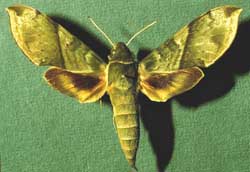
Xylophanes pistacina
Fw apex slightly produced, pointed.
O. m. hollowed out below apex,
evenly convex to anal angle.
G.c. variable: greenish-buff.
Three subparallel am lines, angled at
CUA1.
First two pm lines form broadly
preapical, prominent, straight, slightly oblique, dark band.
Third pml very faint.
Fourth pml distinct, vein dots.
Fifth pml curved from apex,
continuous with greenish olive patch from M2 to M3.

Xylophanes tyndarus*
|
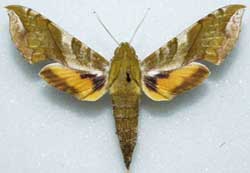
Xylophanes pluto
Tegulae: dark brown edges.
Fw apex slightly produced, pointed.
O. m. hollowed out below apex,
evenly convex, smooth or slightly crenulate, to anal angle.
Five subparallel am lines, evenly convex.
First pml thin but distinct,
slightly oblique, recurved toward body at costa.
Additional pmls very dentate, less distinct.
Prominent white subapical, basal-median suffusions.
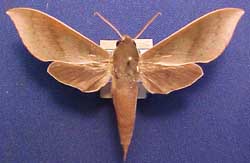
X. po. continentalis *
|
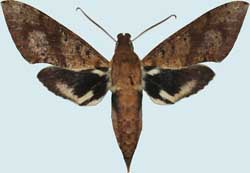
Xylophanes rufescens
G. c.: buff with scattered black spots, most concentrated on costa,
and rusty-brown spots and markings.
Am lines: incomplete bands of irregular black dots/blobs in convex arc
from below costa, terminating before i. m..
Rusty brown pm band is broadly preapical, subparallel to straight outer margin.
Broad rusty brown convex arc just outside cell,
semicirular rusty brown curve outside pml from M1 to CUA1.
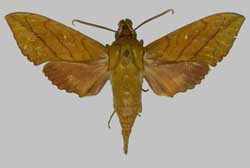
Xylophanes ploetzi
|
|
|

